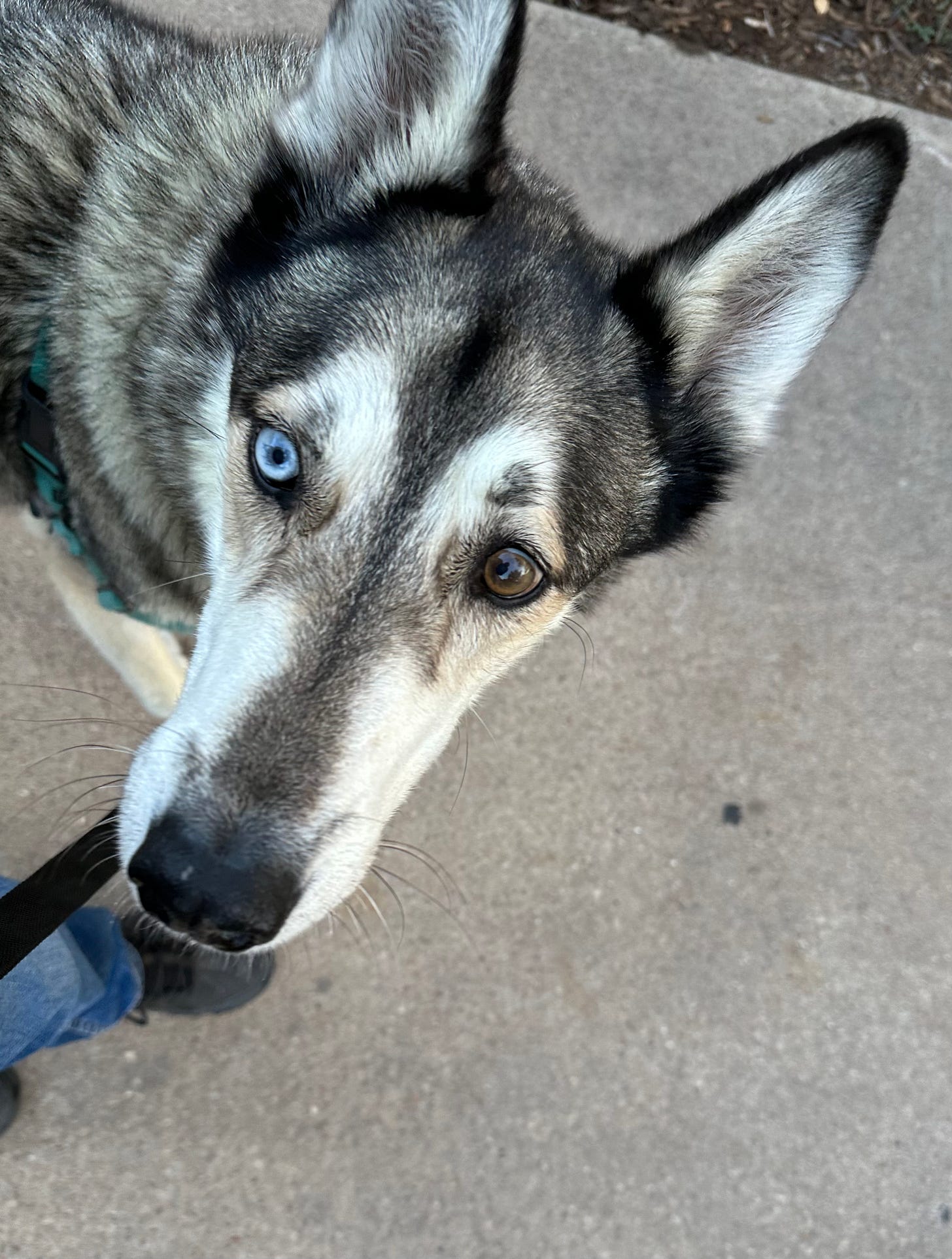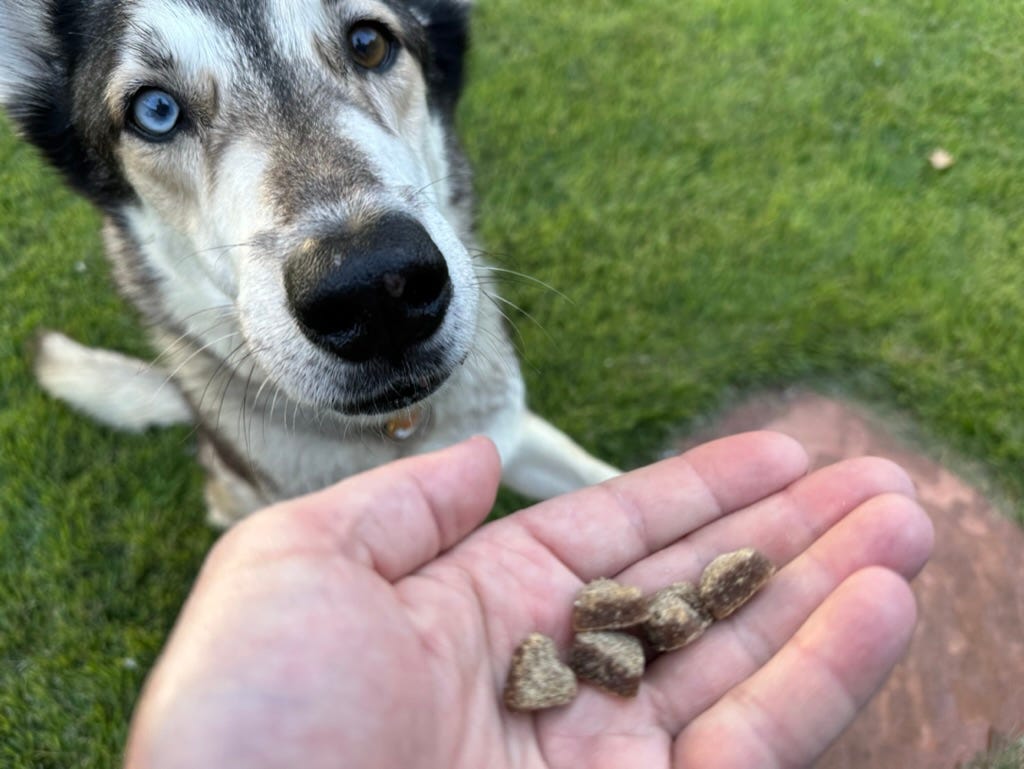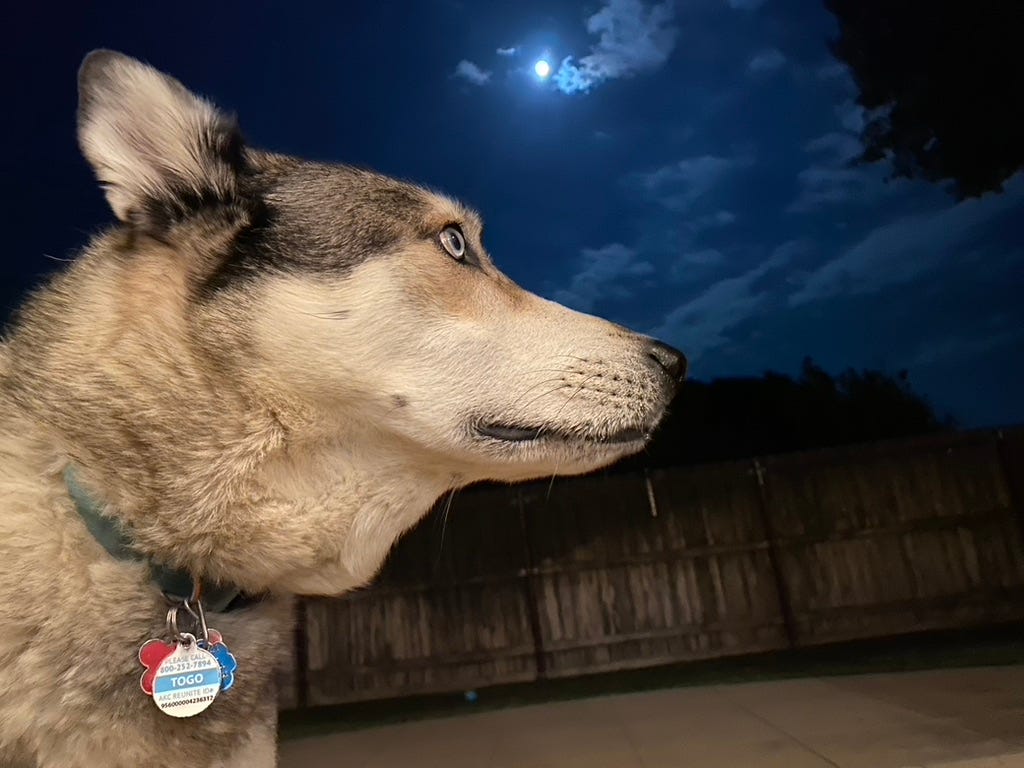I know that all of my readers find humor in pointing out how easily dogs can be distracted. Admit it, haven’t you chuckled when we have gone on high alert? SQUIRREL!!!! And some added delight when we can never seem to catch one?1
Feigned distractions are all part of our master canine plan to dominate humans and keep them squarely beneath our dew claws. Through the ages, dogs have been careful to factor in a great deal of nap and daily contemplation time. Leveraging this practice, we have observed and determined that humans are far more distracted than dogs. And we bear no shame exploiting this weakness, even as humans falsely feel superior in intellect.
In an earlier Togo Goes, I provided training tips and presented several ideas for treat management. In this issue of Togo Goes, I want to provide some advanced techniques growing on my research of Daddy’s distractedness.
Just this morning on our walk, we came upon a designated treat distribution point — Ms. Rita’s front sidewalk. Just like clockwork, Daddy reached into his treat pouch, produced a doggie treat, and delivered it to my waiting mouth. Such precision has never been exceeded — even in a gold medal ice skating performance. I was extremely pleased and proud of Daddy in this moment. Except . . .
I looked up into Daddy’s eyes and noticed that there was nothing going on in his head. No, really. Just gaze into Daddy’s eyes some time. Don’t be weird about it. There is a marked blankness there when he is distracted.
With all the subtlety I could muster, I strolled along a couple of steps and then leaned into Daddy and looked up sharply. I was thrilled to see that Daddy had the same blank look. And then, the magic happened. I call it the “Benefit of the Dog Response.”2
Daddy reached into his bag of treats and delivered another. At the same time saying, “Sorry about that, buddy. Thanks for reminding me.”
I’ve observed a unique feature of the human-dog relationship. When distracted, a human is easily manipulated to do what the dog wants. At some point in its mental reasoning, the human will decide in the dog’s favor. Thus, “For the Benefit of the Dog.”
i’ve done some work with creating artificial moments of distractedness. On our walks, Daddy is frequently drawn into conversation with people we know. I make a big deal out of waiting patiently, often drawing admiring comments from onlookers. You can see the pride in Daddy’s eyes and his hand moves to his treat pouch and I score another treat! So, with that preconditioning, I’ve begun trying to exploit his distractedness.
Yesterday, we passed a neighbor out in his yard. It was 32º and no time for a chat, so Daddy just waved, the neighbor waved back, and I delivered a perfunctory “S’up?!” Without breaking stride, we continued down the street and I executed the Benefit of the Dog move. To my delight, Daddy delivered a treat. A look into his eyes showed that he was distracted and the action was reflex.
Daddy also rewards me when we suddenly find ourselves in close proximity to another dog or a cat. In my younger years, I was pretty protective and went into an aggressive stance. And barked my big bark. Over time I learned that being cool in those moments would often bring Daddy’s praise — and you guessed it, treats.
So this morning as we were walking along our neighborhood route, a big black and white cat decided to be clever and it “hid” behind a flower stem. To be honest, the foolhardiness of this cat took both Daddy and me by surprise. We were within inches of it before we noticed it. In the spirit of full transparency. I admit that I would have lunged at it had I not been so surprised. Instead, we kept moving forward — both of us looking back at that cat.
I realized that Daddy’s brain might have categorized this moment with our other close encounters in the past. I immediately leaned in, gave Daddy the look, and opened my mouth expectantly. To my chagrin, Daddy was so distracted by the cat that he was still looking back and missed his For the Benefit of the Dog opening.
Lesson learned: Timing is everything in For the Benefit of the Dog transactions.
I designed my research around treat delivery. But I am already seeing other applications involving moments similar to distraction. For example, I can easily convince Daddy to let me out multiple times in the night to do my business — even if it’s only been a few minutes since the last time. Sleepiness is much like distractedness in that it is a separation from reality. I’ve exploited that the last couple of nights with a significant showing of response.3
Perhaps this bit of scientific discovery will be of use to you. In the meantime, I have applied for a generous National Science Foundation grant. My research question is whether the “For the Benefit of the Dog Response” led to the variation between fellow humans known as “For the Benefit of the Doubt Response.” It doesn’t seem to have caught on as well among humans. My theory is that when both participants are distracted — or selfish — at the same time, it just doesn’t work.4
That, by the way, is the plot strategy behind the long-running Wile E. Coyote versus Roadrunner cartoon series. Dogs know this and that is why we only catch a squirrel by accident or by a squirrel’s serious miscalculation. After all, the fun is in the chase and the inanity of the squirrel’s trash-talking between chases.
I’ve submitted a scientific paper by that very name to some peer-reviewed journals. So far, not much interest. Admittedly, my peers are fellow dogs and there just isn’t much interest in reading boring, heavily-footnoted articles. Some of the younger dogs are into TikTok and that could be worth exploring except for the fact that I’m an old dog. Yes, old dogs can learn new tricks. But I’m perfectly happy allowing the world to conform to me.
I’ve also observed that the morning after offers additional opportunities for seeming distraction. When Daddy is tired from missing sleep the night before, he’s more distracted. While this is an interesting and often serendipitous phenomenon, a side effect is sufficient crankiness that leads to cessation of all Benefit of the Dog tendencies.
If I can establish a connection between the two and find organic ways to nurture and multiply the “For the Benefit of the Doubt Response.” I’m thinking the Nobel Peace Prize may be within my grasp!







Great research Togo. Time to update those Behaviorist theories with real time data. :)